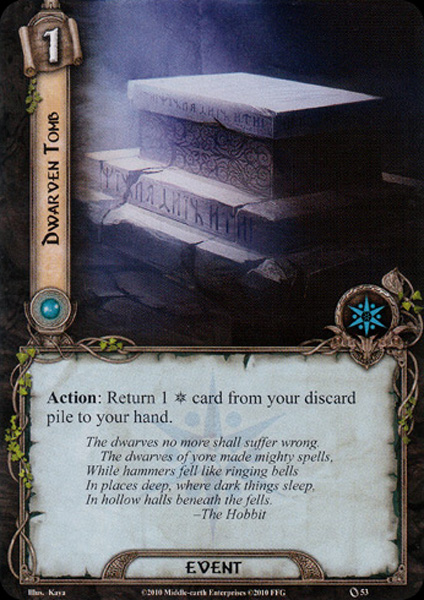A very simple but potentially very effective effect. One of two cards (the other being Stand and Fight) which immediately in the Core Set marked out as the primary sphere for recursion effects. It's a very simple, but very effective ability. But despite its power I would also consider it well-balanced. The ability to recur things over and over is potent to be sure, and it offers incredible flexibility to decks, which for a cost of an extra 1 resource can treat any card in their discard pile as in their hand. The thing is though, any serious balance issues with Dwarven Tomb I would say are more issues with the cards it's being used to recur than with the Tomb itself.
So let's talk about why this card is so good, and about its limitations. It's not for every deck, of course - many decks will be happy to simply draw and play things from hand, and to only play each card once. But some decks want to use their events multiple times, while others may get enthusiastic about discarding from their hand or their deck. In such decks as those this may well be the perfect card. And sometimes it's just nice to have that flexibility.
The flexibility is the biggest point in its favour, as I've already alluded to. You can use Dwarven Tomb to get back an ally who died, an ally who you discarded to a player or encounter card effect, a temporary attachment, an attachment which was discarded by an encounter card effect, an event you played, or of course any card which you discarded from hand or discarded from your deck. The recent support for Noldor discard mechanics and the Dwarven deck-mining mechanic have given Dwarven Tomb a serious resurgence. Of course it's limited by the fact it can only target cards, but at the time of writing a search on RingsDB for cards which aren't heroes in the spirit sphere returns 116 results, which is easily enough to be getting on with. Now if you want to use your recursion for events, it might seem like the Map of Earnil is more flexible, since you don't have to choose which event you want to recur in advance - on the other hand though, the Map requires an action window to trigger it and you can take the same approach with the Tomb, on top of which you can use Dwarven Tomb to pull back events which are responses (like A Test of Will) in advance, which the Map cannot do. Finally of course, Dwarven Tomb always costs 1 whereas the Map only costs 1 if you're mono-sphere.
Dwarven Tomb is a card which can easily be pigeonholed into just a way of recycling Test of Will, and while that may well be the most potent option since Test of Will is an incredibly powerful card, the fact you have that flexibility is what drives Dwarven Tomb into being a truly great card. In a Caldara deck you may well use it to recur Fortune or Fate. If your threat is a concern you can obviously use it to recur threat reduction. In a dwarven mining deck of course you can recur anything you've been mining away, but most especially Imladris Stargazer or Zigil Miner. In a Palantir deck I've used it to recur Minas Tirith Lampwright to cancel a Surge which I've scried. If a quest has attachment discarding effects you can bring back your Unexpected Courage or Mirror of Galadriel or To the Sea, to the Sea! or whatever else is absolutely key to your deck's strategy. In any deck which goes crazy with its discards (from hand or deck) you may want it to recycle Will of the West. The options are far too extensive to list all of them, which is basically my whole point. You can do so much with Dwarven Tomb, it's such a flexibly powerful card, granting you additional access to various other powerful cards, it just opens up so many options and that makes it one of the most potentially interesting cards released in the Core Set.
